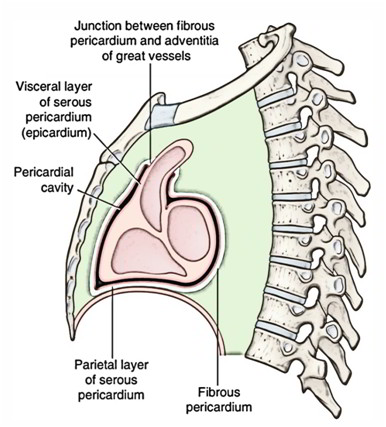1
Question
Write a note on pericardium.
Open in App
Solution
The heart sits within a fluid-filled cavity called the pericardial cavity. The walls and lining of the pericardial cavity are a special membrane known as the pericardium. The pericardium is a type of serous membrane that produces serous fluid to lubricate the heart and prevent friction between the ever beating heart and its surrounding organs. Besides lubrication, the pericardium serves to hold the heart in position and maintain a hollow space for the heart to expand into when it is full. The pericardium has 2 layers—a visceral layer that covers the outside of the heart and a parietal layer that forms a sac around the outside of the pericardial cavity.
Functions - - Restricts excessive movements of the heart,
- Acts as a lubricated container where the heart can contract and relax smoothly, and
- It limits cardiac distension.

The heart sits within a fluid-filled cavity called the pericardial cavity. The walls and lining of the pericardial cavity are a special membrane known as the pericardium. The pericardium is a type of serous membrane that produces serous fluid to lubricate the heart and prevent friction between the ever beating heart and its surrounding organs. Besides lubrication, the pericardium serves to hold the heart in position and maintain a hollow space for the heart to expand into when it is full. The pericardium has 2 layers—a visceral layer that covers the outside of the heart and a parietal layer that forms a sac around the outside of the pericardial cavity.
Functions -
- Restricts excessive movements of the heart,
- Acts as a lubricated container where the heart can contract and relax smoothly, and
- It limits cardiac distension.

Suggest Corrections
4
View More
Join BYJU'S Learning Program
Join BYJU'S Learning Program
